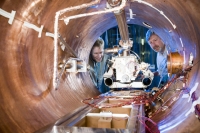 |
 |
|||||||||||||
|
|||||||||||||
|
|||||||||||||
|
The newest resident in Fermilab’s Meson Detector Building is up and running. Last week, Fermilab scientists installed a nine-cell 1.3 GHz TESLA-style cavity into a cryostat in order to commission the new Horizontal Test Stand. Designed to test both 3.9 Ghz and 1.3 Ghz 9-cell niobium cavities, the Horizontal Test Stand will play an important role in the growing ILC R&D programme at Fermilab. When a cavity makes it to the horizontal test stand, it has already jumped a bunch of hurdles, indicating that it is worthy of taking one step closer to becoming part of the actual accelerator. In order to qualify for the Horizontal Test Stand, the bare cavity first gets tested in the Vertical Test Stand. In the U.S., vertical test stands are located at Cornell, JLab, and at a new facility in Fermilab’s Industrial 1 Building. After a cavity passes the vertical test, it gets welded inside a helium vessel and dressed with a power coupler and tuner. This process is both expensive and time consuming and is reserved only for cavities that are deemed likely to meet performance goals. “When a nine-cell bare cavity becomes a fully dressed cavity, you suddenly have something quite different that requires another test to see how it will now perform,” says Fermilab physicist Andy Hocker. The horizontal is intended to mimic how it will be cooled and RF powered in the final cryomodule in the accelerator, only without the beam. As opposed to the vertical tests, which use lower power CW (continuous wave) RF, the horizontal test applies a much larger pulsed RF power to the cavity. Approximately 300 kW (kilowatts) of RF power will get switched on for about 1.5 ms (milliseconds) at a time and repeated five times per second. “This is the first time that the cavity will experience pulsed RF power similar to the conditions inside the ILC,” says Fermilab ILC Director Bob Kephart. When testing horizontally, the cavity first undergoes RF processing, a procedure where physicists apply high power RF to blast away any lingering impurities. Similar to a stress test, physicists then apply as much power to the cavity as possible before it quenches, or fails, to see just how much it can tolerate. For the ILC cavities, the target is to reach an accelerating gradient of 35 mV/m (megavolts per metre) and a Q (quality) factor of 1010. A lower Q factor will indicate that the cavity is losing power and thus not fully efficient. The tuner motor and other components also get tested while inside the Horizontal Test Stand, giving the cavity a thorough exam before it can graduate and become part of a cryomodule. Between testing the cavity vertically and horizontally, the cavity sometimes will often show a loss in accelerating gradient. This decrease is a puzzling challenge that is most likely due to variability steps that make up the dressing process. “We will have to learn how to improve those steps to minimize any degradation,” Kephart says. Another important purpose of the HTS test is to validate the cavity performance before introducing the dressed cavity into a cryomodule. After commissioning the HTS with a 1.3 GHz cavity, Fermilab will start testing 3.9 GHz cavities built for DESY’s TTF/FLASH accelerator in the Horizontal Test Stand later this spring. The goal is for each test to take approximately ten days, although Fermilab expects that the first few tests will take two to three times longer as they learn to run their new facility. -- Elizabeth Clements |
|||||||||||||
| © International Linear Collider |
